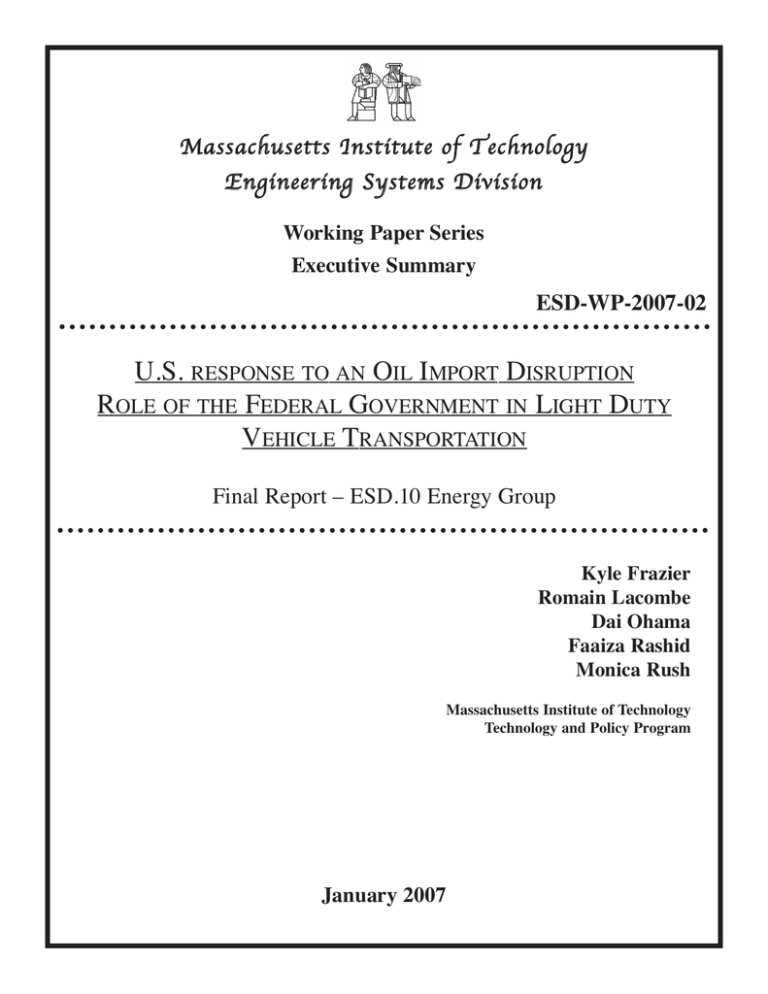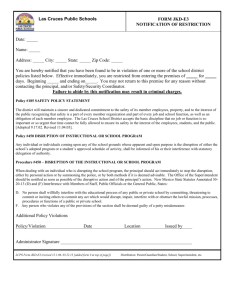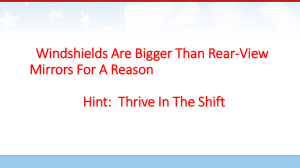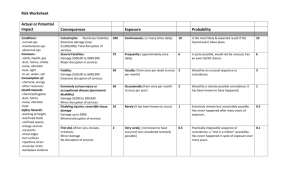M Maassssaacchhuusseettttss IInnssttiittuuttee ooff T Teecchhnnoollooggyy E
advertisement

Massachusetts Institute of Technology Engineering Systems Division Working Paper Series Executive Summary ESD-WP-2007-02 U.S. RESPONSE TO AN OIL IMPORT DISRUPTION ROLE OF THE FEDERAL GOVERNMENT IN LIGHT DUTY VEHICLE TRANSPORTATION Final Report – ESD.10 Energy Group Kyle Frazier Romain Lacombe Dai Ohama Faaiza Rashid Monica Rush Massachusetts Institute of Technology Technology and Policy Program January 2007 Executive Summary This report analyzes technological and policy options for the U.S. federal government response within the light duty vehicle (LDV) sector in the event of a 5 year sustained U.S. oil import curtailment of 5 MMB/D and a global supply disruption of roughly 18 MMB/D. The cause of the oil disruption is damage to the oil production infrastructure in the Middle East; therefore, it is public knowledge that the disruption will be sustained. LDV transportation was chosen as the scope of this report’s policy analysis since it accounts for over 42 percent of total U.S. petroleum products. Within LDV transportation sector, three main avenues of action namely vehicle efficiency, alternative fuels and efficient use of vehicles were examined for policy options. The first two avenues are technological and the third is behavioral in impact. Since the options are numerous within each of these avenues, a policy decision analysis was performed to scope the policy options to ones that were pertinent to government intervention and the 5 year disruption time horizon. Within fuel efficiency of vehicles there is not a strong case for government intervention primarily because irrespective of the oil disruption, manufacturers will continue to make efficiency gains. In the event of an oil supply disruption, savings could be achieved using a combination of more stringent CAFE standards and market forces to encourage continued development and adoption of fuel saving technologies. These incentives could be put in place within one year after start of the disruption, allowing results within the five-year time frame. Key findings of the report show that within alternative fuels there is a case for government intervention. In alternative fuels the largest barrier to commercialization is lack of critical mass and lack of infrastructure—a problem often known as the chicken and the egg dilemma. Government can play a key role post oil disruption to target investment in alternative fuels to begin to solve the chicken and the egg dilemma. Other barriers to alternative fuels are related with cost; however, in the case of a disruption these barriers will cease to be major barriers due to the rise in prices of gasoline. A third area of oil consumption reduction in the light duty vehicle sector is through vehicle usage efficiency. This includes a consideration of public transportation, high occupancy vehicle use, speed limits and vehicle turnover rate. This report finds that in the context of the disruption there is a case for government action in each of these areas. The overall timeline of policy implementation has regulations being made within the first year after the disruption in each of the three areas. However, no substantial gains will be seen in either alternative fuels, vehicle fuel efficiency and public transportation until the third year and after wards. Leading up to the third year, there could be government action in vehicle usage efficiency, specifically speed limits, HOV policies as well as in employing E85 in the flex-fuel vehicles that are already part of the vehicle fleet. The policy options considered within this report aim to generate an implementation momentum rather than simply cause short-term behavior changes in stakeholders due to unsustainable cost-incentives. This report does not seek to recommend certain policies over others, instead it is meant as a portfolio of policy tools that could be employed in the context of the disruption scenario and could be used as a framework for policy analysis at a level other than the federal government. 1





